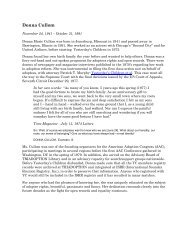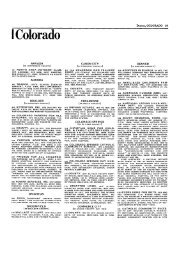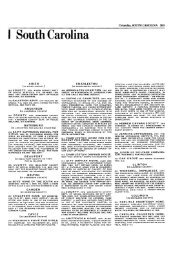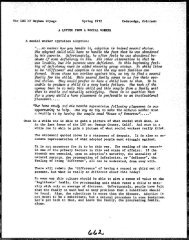TRIADOPTION ® Library, Inc. - CA ~ Pg 369-480
TRIADOPTION ® Library, Inc. - CA ~ Pg 369-480
TRIADOPTION ® Library, Inc. - CA ~ Pg 369-480
Create successful ePaper yourself
Turn your PDF publications into a flip-book with our unique Google optimized e-Paper software.
teacher by telephone. Respondents represented<br />
about half the total students<br />
ei~rol'led in the program during the first<br />
six years of its existence. Some inter-<br />
esting -- and quite positive -- information<br />
about young mothers was revealed.<br />
Sixty-four (63 per cent) of the respondents<br />
have graduated from high<br />
school. An additional nine were still<br />
in high school. Only 28 percent of the<br />
TMP dlumnae have dkopped out -- a sharp<br />
contrast to the 80 percent dropout rate<br />
for young mothers generally.<br />
Sixteen of the high school graduates<br />
(33 percent of the graduat;s, 16<br />
percent of the total respondents) are<br />
either in college or have been enrolled<br />
in college classes.<br />
Eighty-seven (86 percent) of the<br />
respondents have worked in the past<br />
and/or are working now. Of the remaining<br />
twenty-four, t;n are still in school.<br />
Eleven of the others are married. Only<br />
three of the mothers who are single and<br />
not in school have never been employed,<br />
one because her child is only seven<br />
months old.<br />
While 71 (70) percent of these former<br />
students were on welfare at some<br />
time, usually during pregnancy and for<br />
a short time afterward, only 23 still<br />
receive AFDC (Aid to Families with Dependent<br />
Children). Of these 23, 10 are<br />
still in school, three are working and<br />
will soon be independent of welfare.<br />
Only one in ten of the respondents is<br />
not working, not in school, and is still<br />
receiving welfare! Each of these young<br />
women is a single mother, and several<br />
n,entioned having worked in the past<br />
and/or planning to go back to school<br />
or find work in the near future.<br />
A<br />
recent Rand Corporation survey<br />
of California families headed by a single<br />
parent under the age of 25 showed 90<br />
percent of these families depending on<br />
welfare if the younq parent had not<br />
earned her/his high school diploma.<br />
TMP alumnae don't fit this statistic!<br />
Half of the respondents (50) are<br />
still with the father of the baby, and<br />
most of these couples are married.<br />
Some young mothers offered advice<br />
to other teenagers. Typical was the<br />
follow in C q : "Having children at a young<br />
age is satisfying to me, but sometimes<br />
I wish I had waited. I love my - children,<br />
and I wouldn't give them up for<br />
anything, but 1 don't advise anyone<br />
who has big plans to get pregnant too<br />
young. Your children should always<br />
come first, and with plans for the future,<br />
it's not always possible to spend<br />
enough time with them. 11<br />
Another young mother commented,<br />
"I think having children is a very big<br />
responsibility. Lots of kids nowadays<br />
think that having a baby will help a<br />
marriage or make you more qrownup.<br />
1t isnc't so. A child needs La stable<br />
home life and lots and 1ots.01 attention<br />
You have to give up alot of 'your.ow~<br />
life -- but they're worth it .I1'<br />
Teenage Motherhood: Social and<br />
Economic Consequences was published<br />
last year by - The Urban Institute, WashinRton,<br />
D.C. Authors Moore et a1 based'<br />
their report on a massive research study<br />
funded by the Center for Population Research,<br />
National Institutes of Health,<br />
U. S. Department of Health, Education,<br />
and Welfare. Results of this research<br />
showed the tremendous impact of early<br />
childbearing on education, family size,<br />
earnings, and welfare dependency .-<br />
After<br />
carefully revie::~ing the re-<br />
search, the authors made the foilowinc~ .-J<br />
recommendations concernin: the specj a1<br />
help young mothers need in order to<br />
continue their education:<br />
.The loss of education associated with a .birth<br />
durin the high school years has important and<br />
long-!asting consequences. Women with less<br />
education have larger families, experience more<br />
frequent marital instability, work less, are<br />
employed at lower paying jobs, are more likely<br />
to experience poverty, and have a higher probability<br />
of requiring public assistance tha'n<br />
their better-educated peers. This suggests<br />
the importance of programs that enable teenage<br />
mothers to continue their schooling. ..<br />
Special programs in the schools are needed to<br />
assist and encourage teenage mothers. to remain<br />
in school. Infant day care is a crltical requirement<br />
for these young mothers. Special<br />
counseling may be necessary to help mothers<br />
cope with the multiple demands on their time<br />
and energy. Technical or vocational trainin<br />
mi ht prove useful for young wo en confronte<br />
wi 9 h the need to support a child. !'<br />
i

















